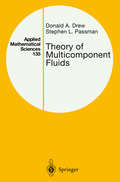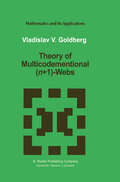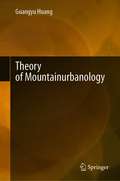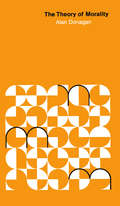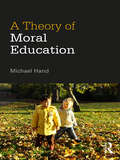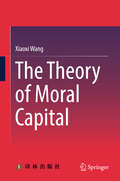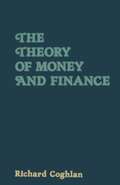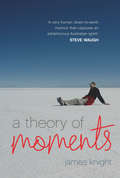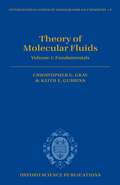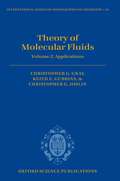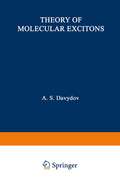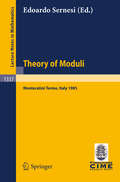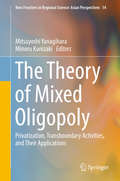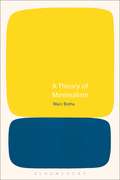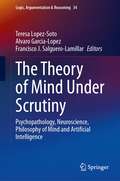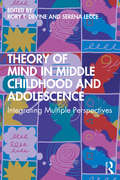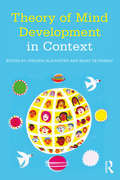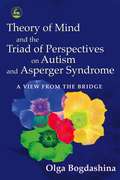- Table View
- List View
Theory of Multicomponent Fluids (Applied Mathematical Sciences #135)
by Donald A. Drew Stephen L. PassmanAn exposition of the derivation and use of equations of motion for two-phase flow. The approach taken derives the equations of motion using ensemble averaging, and compares them with those derived from control volume methods. Closure for dispersed flows is discussed, and some fundamental solutions are given. The work focuses on the fundamental aspects of two-phase flow, and is intended to give the reader a background for understanding the dynamics as well as a system of equations that can be used in predictions of the behavior of dispersed two-phase flows. The exposition in terms of ensemble averaging is new, and combining it with modern continuum mechanics concepts makes this book unique. Intended for engineering, mathematics and physics researchers and advanced graduate students working in the field.
Theory of Multicodimensional (Mathematics and Its Applications #44)
by Vladislav V. GoldbergApproach your problems from the right end It isn't that they can't see the solution. It is and begin with the answers. Then one day, that they can't see the problem. perhaps you will find the final question. G. K. Chesterton. The Scandal of Father 'The Hermit Clad in Crane Feathers' in R. Brown 'The point of a Pin'. van Gulik's The Chinese Maze Murders. Growing specialization and diversification have brought a host of monographs and textbooks on increasingly specialized topics. However, the "tree" of knowledge of mathematics and related fields does not grow only by putting forth new branches. It also happens, quite often in fact, that branches which were thought to be completely disparate are suddenly seen to be related. Further, the kind and level of sophistication of mathematics applied in various sciences has changed drastically in recent years: measure theory is used (non-trivially) in regional and theoretical economics; algebraic geometry interacts with physics; the Minkowsky lemma, coding theory and the structure of water meet one another in packing and covering theory; quantum fields, crystal defects and mathematical programming profit from homotopy theory; Lie algebras are relevant to filtering; and prediction and electrical engineering can use Stein spaces. And in addition to this there are such new emerging subdisciplines as "experimental mathematics", "CFD", "completely integrable systems", "chaos, synergetics and large-scale order", which are almost impossible to fit into the existing classification schemes. They draw upon widely different sections of mathematics.
Theory of Mountainurbanology
by Guangyu HuangThis book is about mountainurbanology grounded in Southwest China, where mountain is a typical landform for many towns and cities. From the multi-disciplinary perspective in a dynamic changing context, it presents a comprehensive framework including the location of mountain city, planning, design, building, transportation, disaster, aesthetics and governance in building up mountain cities based on investigation of natural, social and economic studies. The book also emphasizes ecological planning method based on topography in mountainous area through the lens of teaching and practice on urban planning for over half a century in Southwest China. It is a highly informative book providing academic insight for senior undergraduates, graduate students, lecturers, research professionals and decision makers with an interest in urban planning, ecology, planning and design in mountainous region development. Prof. Guangyu Huang is regarded as Founding Pioneer of mountainurbanology in China, a sub-discipline of urban planning.
The Theory of Morality
by Alan Donagan"Let us . . . nominate this the most important theoretical work on ethical or moral theory since John Rawls's Theory of Justice. If you have philosophical inclinations and want a good workout, this conscientious scrutiny of moral assumptions and expressions will be most rewarding. Donagan explores ways of acting in the Hebrew-Christian context, examines them in the light of natural law and rational theories, and proposes that formal patterns for conduct can emerge. All this is tightly reasoned, the argument is packed, but the language is clear."—Christian Century "The man value of this book seems to me to be that it shows the force of the Hebrew-Christian moral tradition in the hands of a creative philosopher. Throughout the book, one cannot but feel that a serious philosopher is trying to come to terms with his religious-moral background and to defend it against the prevailing secular utilitarian position which seems to dominate academic philosophy."—Bernard Gert, Journal of Medicine and Philosophy
The Theory of Morality
by Alan Donagan"Let us . . . nominate this the most important theoretical work on ethical or moral theory since John Rawls's Theory of Justice. If you have philosophical inclinations and want a good workout, this conscientious scrutiny of moral assumptions and expressions will be most rewarding. Donagan explores ways of acting in the Hebrew-Christian context, examines them in the light of natural law and rational theories, and proposes that formal patterns for conduct can emerge. All this is tightly reasoned, the argument is packed, but the language is clear."—Christian Century "The man value of this book seems to me to be that it shows the force of the Hebrew-Christian moral tradition in the hands of a creative philosopher. Throughout the book, one cannot but feel that a serious philosopher is trying to come to terms with his religious-moral background and to defend it against the prevailing secular utilitarian position which seems to dominate academic philosophy."—Bernard Gert, Journal of Medicine and Philosophy
The Theory of Morality
by Alan Donagan"Let us . . . nominate this the most important theoretical work on ethical or moral theory since John Rawls's Theory of Justice. If you have philosophical inclinations and want a good workout, this conscientious scrutiny of moral assumptions and expressions will be most rewarding. Donagan explores ways of acting in the Hebrew-Christian context, examines them in the light of natural law and rational theories, and proposes that formal patterns for conduct can emerge. All this is tightly reasoned, the argument is packed, but the language is clear."—Christian Century "The man value of this book seems to me to be that it shows the force of the Hebrew-Christian moral tradition in the hands of a creative philosopher. Throughout the book, one cannot but feel that a serious philosopher is trying to come to terms with his religious-moral background and to defend it against the prevailing secular utilitarian position which seems to dominate academic philosophy."—Bernard Gert, Journal of Medicine and Philosophy
The Theory of Morality
by Alan Donagan"Let us . . . nominate this the most important theoretical work on ethical or moral theory since John Rawls's Theory of Justice. If you have philosophical inclinations and want a good workout, this conscientious scrutiny of moral assumptions and expressions will be most rewarding. Donagan explores ways of acting in the Hebrew-Christian context, examines them in the light of natural law and rational theories, and proposes that formal patterns for conduct can emerge. All this is tightly reasoned, the argument is packed, but the language is clear."—Christian Century "The man value of this book seems to me to be that it shows the force of the Hebrew-Christian moral tradition in the hands of a creative philosopher. Throughout the book, one cannot but feel that a serious philosopher is trying to come to terms with his religious-moral background and to defend it against the prevailing secular utilitarian position which seems to dominate academic philosophy."—Bernard Gert, Journal of Medicine and Philosophy
A Theory of Moral Education
by Michael HandChildren must be taught morality. They must be taught to recognise the authority of moral standards and to understand what makes them authoritative. But there’s a problem: the content and justification of morality are matters of reasonable disagreement among reasonable people. This makes it hard to see how educators can secure children’s commitment to moral standards without indoctrinating them. In A Theory of Moral Education, Michael Hand tackles this problem head on. He sets out to show that moral education can and should be fully rational. It is true that many moral standards and justificatory theories are controversial, and educators have an obligation to teach these nondirectively, with the aim of enabling children to form their own considered views. But reasonable moral disagreement does not go all the way down: some basic moral standards are robustly justified, and these should be taught directively, with the aim of bringing children to recognise and understand their authority. This is an original and important contribution to the philosophy of moral education, which lays a new theoretical foundation for the urgent practical task of teaching right from wrong.
A Theory of Moral Education
by Michael HandChildren must be taught morality. They must be taught to recognise the authority of moral standards and to understand what makes them authoritative. But there’s a problem: the content and justification of morality are matters of reasonable disagreement among reasonable people. This makes it hard to see how educators can secure children’s commitment to moral standards without indoctrinating them. In A Theory of Moral Education, Michael Hand tackles this problem head on. He sets out to show that moral education can and should be fully rational. It is true that many moral standards and justificatory theories are controversial, and educators have an obligation to teach these nondirectively, with the aim of enabling children to form their own considered views. But reasonable moral disagreement does not go all the way down: some basic moral standards are robustly justified, and these should be taught directively, with the aim of bringing children to recognise and understand their authority. This is an original and important contribution to the philosophy of moral education, which lays a new theoretical foundation for the urgent practical task of teaching right from wrong.
The Theory of Moral Capital
by Xiaoxi WangThis book captures the quintessence of the author’s 20-year career, presenting both unique perspectives and logical arguments. Guided by the Marxist concept of historical materialism, it reveals the function and effect of morality by analyzing and defining the moral domain. Further, it argues that economic development requires moral support by analyzing the inseparable logical connection between economics and morality. Moreover, it investigates moral capital and its route to achieving value multiplication in economic activities, and proposes a practice and evaluation index system for moral capital in enterprises. Combining philosophical analysis and the exploration of practical applications, the book also discusses a basic strategy to help enterprises enrich and manage their moral capital.
A Theory of Moments
by James KnightApproaching forty, with the predictable mortgage, career and comfortable surburan lifestyle, James Knight knew he was one of the lucky ones. He loved his wife and he had his health (occasionally the black dog would bite, but he'd learnt to manage this...most of the time), yet something wasn't quite right. Married less than a year, he and Clare weren't finding time for each other or themselves. Surely there must be more to life than the daily commute, the occasional trip away and rampant consumerism?The death of a good friend's mother gave James the perspective he needed to set out on a year-long journey through Latin America and Africa with Clare, doing voluntary work, learning Spanish and dancing whereever and whenever they could. This trip would change their lives in ways they never expected, teaching them that cherishing every moment is what matters above all else.
Theory of Molecular Fluids: I: Fundamentals (International Series of Monographs on Chemistry #9)
by C. G. Gray K. E. GubbinsTheory of Molecular Fluids I: Fundamentals
Theory Of Molecular Fluids: Volume 2: Applications (International Series of Monographs on Chemistry #10)
by Christopher G. Gray Keith E. Gubbins Christopher G. JoslinExisting texts on the statistical mechanics of liquids treat only spherical molecules. However, nearly all fluids of practical interest are composed of non-spherical molecules that are often dipolar or exhibit other kinds of electrostatic forces. This book describes the statistical mechanical theory of fluids of non-spherical molecules and its application to the calculation of physical properties, and is a sequel to Theory of Molecular Fluids. Volume 1: Fundamentals by C.G. Gray and K.E. Gubbins. The emphasis is on the new phenomena that arise due to the non-spherical nature of the intermolecular forces, such as new phase transitions, structural features and dielectric effects. It contains chapters on the thermodynamic properties of pure and mixed fluids, surface properties, X-ray and neutron diffraction structure factors, dielectric properties and spectroscopic properties. The book is aimed at beginning graduate students and research workers in chemistry, physics, materials science and engineering.
Theory of Moduli: Lectures given at the 3rd 1985 Session of the Centro Internazionale Matematico Estivo (C.I.M.E.) held at Montecatini Terme, Italy, June 21-29, 1985 (Lecture Notes in Mathematics #1337)
by Edoardo SernesiThe contributions making up this volume are expanded versions of the courses given at the C.I.M.E. Summer School on the Theory of Moduli.
The Theory of Mixed Oligopoly: Privatization, Transboundary Activities, and Their Applications (New Frontiers in Regional Science: Asian Perspectives #14)
by Mitsuyoshi Yanagihara Minoru KunizakiThis book outlines the core concept of the theory of mixed oligopoly and presents recent results that have arisen in a mixed oligopolistic market. The wave of privatization since the 1980s has taken the development of the theory of mixed oligopoly in several directions. Although the main concern of the theory of mixed oligopoly focuses on the effect of regime change—especially privatization of a public firm—on social welfare, existing studies have not considered the difference in economic environments. With drastic changes in economic environments along with economic development in recent years, the domestic and foreign markets have become more and more integrated, firms have become concerned about corporate social responsibility, and governments or politicians have had various interests and preferences. Against that background, this book revisits the question of how privatization affects social welfare by incorporating regional and international interdependency and investigates how firms’ activities for corporate social responsibility, governments’ preferences, and political economic situations affect the market circumstance in a mixed oligopoly. The dynamic aspect of privatization is also investigated.
A Theory of Minimalism
by Marc BothaThe explosion of minimalism into the worlds of visual arts, music and literature in the mid-to-late twentieth century presents one of the most radical and decisive revolutions in aesthetic history. Detested by some, embraced by others, minimalism's influence was immediate, pervasive and lasting, significantly changing the way we hear music, see art and read literature. In The Theory of Minimalism, Marc Botha offers the first general theory of minimalism, equally applicable to literature, the visual arts and music. He argues that minimalism establishes an aesthetic paradigm for rethinking realism in genuinely radical terms. In dialogue with thinkers from both the analytic and continental traditions – including Kant, Danto, Agamben, Badiou and Meillassoux – Botha develops a constellation of concepts which together encapsulate the transhistorcial and transdisciplinary reach of minimalism. Illustrated by a range of historical, canonical and contemporary minimalist works of different media, from the caves of early Christian ascetics to Samuel Beckett's late prose, Botha offers a bold and provocative argument which will equip readers with the tools to engage critically with past, present and future minimalism, and to recognize how, in a culture caught between the poles of excess and austerity, minimalism still matters.
A Theory of Minimalism
by Marc BothaThe explosion of minimalism into the worlds of visual arts, music and literature in the mid-to-late twentieth century presents one of the most radical and decisive revolutions in aesthetic history. Detested by some, embraced by others, minimalism's influence was immediate, pervasive and lasting, significantly changing the way we hear music, see art and read literature. In The Theory of Minimalism, Marc Botha offers the first general theory of minimalism, equally applicable to literature, the visual arts and music. He argues that minimalism establishes an aesthetic paradigm for rethinking realism in genuinely radical terms. In dialogue with thinkers from both the analytic and continental traditions – including Kant, Danto, Agamben, Badiou and Meillassoux – Botha develops a constellation of concepts which together encapsulate the transhistorcial and transdisciplinary reach of minimalism. Illustrated by a range of historical, canonical and contemporary minimalist works of different media, from the caves of early Christian ascetics to Samuel Beckett's late prose, Botha offers a bold and provocative argument which will equip readers with the tools to engage critically with past, present and future minimalism, and to recognize how, in a culture caught between the poles of excess and austerity, minimalism still matters.
The Theory of Mind Under Scrutiny: Psychopathology, Neuroscience, Philosophy of Mind and Artificial Intelligence (Logic, Argumentation & Reasoning #34)
by Teresa Lopez-Soto Alvaro Garcia-Lopez Francisco J. Salguero-LamillarThis book is a call to expand and diversify our approach to the study of the human mind in relation to the Theory of Mind. It proposes that it is necessary to combine cross-disciplinary methods to arrive at a more complete understanding of how our minds work. Seeking to expand the discussion surrounding the Theory of Mind beyond the field of psychology, and its focus on our capacity to ascribe mental states to other people, this volume collects evidence and research to point to a more holistic understanding of our own minds, the minds of others, behavior, language, and reasoning. This book therefore illuminates the conceptual intricacy underlying the Theory of Mind. It posits that a wide scope is necessary to make a breakthrough in scientific research towards a full understanding of the nature, function, and development of our capacity to converge on biological processes of the brain towards consciousness, emotion, awareness, and cognition. The volume presents methods, results, critiques, and models intended to provoke debates in various academic disciplines. It is of interest to scholars working in psychology, neuroscience, philosophy of mind, and artificial intelligence.
Theory of Mind in Middle Childhood and Adolescence: Integrating Multiple Perspectives
by Rory T. Devine Serena LecceThis landmark text integrates diverse perspectives on how humans understand others’ minds (or ‘theory of mind’) beyond early childhood into middle childhood and adolescence. It explores how the neural, cognitive, and social changes of middle childhood and adolescence shape the ongoing development of theory of mind, and how theory of mind helps children navigate their lives. Drawing on cutting-edge research from leading international experts, this book provides a survey and analysis of the current state and future direction of the field. It is organized around three themes relating to the key issues in contemporary research. The first part focuses on the biological and cognitive bases of theory of mind in middle childhood and adolescence. The second part goes on to explore the social predictors and consequences, considering how theory of mind is shaped by social experiences and, in turn, impacts children’s social lives in middle childhood and adolescence. Finally, the third part focuses on theory of mind in the context of neurodiversity, disability, and youth mental health in middle childhood and adolescence. Offering in-depth understanding for all students and scholars of developmental and cognitive psychology, neuroscience, clinical psychology and psychiatry, and education, this valuable text also identifies an agenda for future scholarship on this exciting topic.
Theory of Mind in Middle Childhood and Adolescence: Integrating Multiple Perspectives
by Rory T. Devine and Serena LecceThis landmark text integrates diverse perspectives on how humans understand others’ minds (or ‘theory of mind’) beyond early childhood into middle childhood and adolescence. It explores how the neural, cognitive, and social changes of middle childhood and adolescence shape the ongoing development of theory of mind, and how theory of mind helps children navigate their lives. Drawing on cutting-edge research from leading international experts, this book provides a survey and analysis of the current state and future direction of the field. It is organized around three themes relating to the key issues in contemporary research. The first part focuses on the biological and cognitive bases of theory of mind in middle childhood and adolescence. The second part goes on to explore the social predictors and consequences, considering how theory of mind is shaped by social experiences and, in turn, impacts children’s social lives in middle childhood and adolescence. Finally, the third part focuses on theory of mind in the context of neurodiversity, disability, and youth mental health in middle childhood and adolescence. Offering in-depth understanding for all students and scholars of developmental and cognitive psychology, neuroscience, clinical psychology and psychiatry, and education, this valuable text also identifies an agenda for future scholarship on this exciting topic.
Theory of Mind Development in Context
by Virginia Slaughter Marc De RosnayTheory of Mind Development in Context is the first book of its kind to explore how children’s environments shape their theory of mind and, in turn, their ability to interact effectively with others. Based on world-leading research, and inspired by the ground-breaking work of Candida Peterson, the original collected chapters demonstrate that children’s understanding of other people is shaped by their everyday environment. Specifically, the chapters illustrate how theory of mind development varies with broad cultural context, socioeconomic status, institutional versus home rearing, family size, parental communication style, and aspects of schooling. The volume also features research showing that, by virtue of their condition, children who are deaf or who have an autism spectrum disorder function in environments that differ from those of typical children and this in turn influences their theory of mind. Although much important research has emphasized the role of nature in theory of mind development, this book highlights that children’s understanding of other people is nurtured through their everyday experiences and interactions. This perspective is essential for students, researchers, and practitioners to gain a complete understanding of how this fundamental skill develops in humans. The book is invaluable for academic researchers and advanced students in developmental psychology, education, social psychology, cognitive psychology, and the social sciences, as well as practicing psychologists, counselors, and psychiatrists, particularly those who deal with disorders involving social and/or communicative deficits.
Theory of Mind Development in Context
by Virginia Slaughter Marc De RosnayTheory of Mind Development in Context is the first book of its kind to explore how children’s environments shape their theory of mind and, in turn, their ability to interact effectively with others. Based on world-leading research, and inspired by the ground-breaking work of Candida Peterson, the original collected chapters demonstrate that children’s understanding of other people is shaped by their everyday environment. Specifically, the chapters illustrate how theory of mind development varies with broad cultural context, socioeconomic status, institutional versus home rearing, family size, parental communication style, and aspects of schooling. The volume also features research showing that, by virtue of their condition, children who are deaf or who have an autism spectrum disorder function in environments that differ from those of typical children and this in turn influences their theory of mind. Although much important research has emphasized the role of nature in theory of mind development, this book highlights that children’s understanding of other people is nurtured through their everyday experiences and interactions. This perspective is essential for students, researchers, and practitioners to gain a complete understanding of how this fundamental skill develops in humans. The book is invaluable for academic researchers and advanced students in developmental psychology, education, social psychology, cognitive psychology, and the social sciences, as well as practicing psychologists, counselors, and psychiatrists, particularly those who deal with disorders involving social and/or communicative deficits.
Theory of Mind and the Triad of Perspectives on Autism and Asperger Syndrome: A View from the Bridge
by Olga BogdashinaInspired by the often uncomfortable interplay between autistic individuals, parents and professionals in understanding autistic spectrum conditions, Olga Bogdashina uses the concept of Theory of Mind (ToM) to consider these groups' different (and often conflicting) perspectives. ToM is the ability to imagine and make judgements about what others feel and think; its absence in autistic individuals is called 'mindblindness'. This book addresses the 'mindblindness' of people united in their interest in autism but divided by their different angles and perspectives. Divided into four parts, the book first defines autism, then the views of the three main groups working with it - autistic individuals, parents and professionals - under the headings of classifications, diagnosis, causes, development, theories and treatment. By comparing and reconciling the different perspectives in this way, the book helps each group to understand and predict each other's responses and behaviours. This enlightening and innovative book offers a unique way of 'stepping in each other's shoes' and is a valuable resource for all people living or working with autism.
